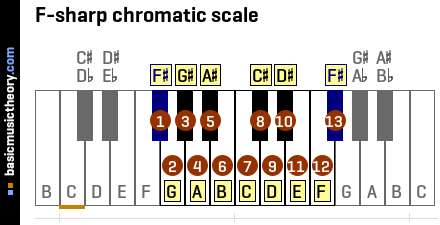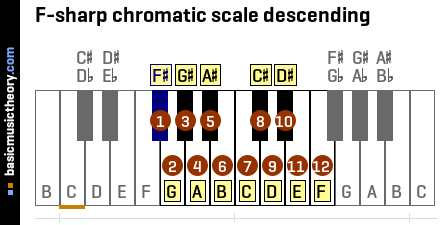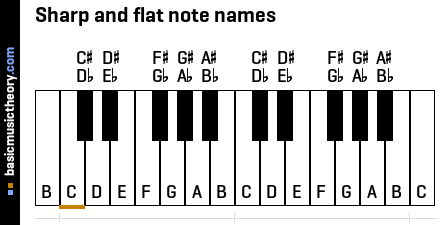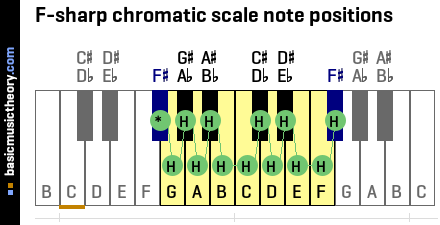F-sharp chromatic scale
The Solution below shows the F# chromatic scale notes on the piano keyboard.
The Lesson steps then explain how to identify the F-sharp chromatic scale note interval positions, and choose the note names.
For a quick summary of this topic, have a look at Chromatic scale.
| Key | C | C# | Db | D | D# | Eb | E | F | [F#] | Gb | G | G# | Ab | A | A# | Bb | B |
|---|
Solution - 2 parts
1. F-sharp chromatic scale
The F-sharp chromatic scale has 12 notes, and uses every half-tone / semitone position. The piano diagram below shows the note positions and note names.
| No. | 1 | 2 | 3 | 4 | 5 | 6 | 7 | 8 | 9 | 10 | 11 | 12 | 13 |
|---|---|---|---|---|---|---|---|---|---|---|---|---|---|
| Note name | F# | G | G# | A | A# | B | C | C# | D | D# | E | F | F# |

 Bass Clef
Bass Clef
 Treble Clef
Treble Clef
2. F-sharp chromatic scale descending

| No. | 1 | 2 | 3 | 4 | 5 | 6 | 7 | 8 | 9 | 10 | 11 | 12 |
|---|---|---|---|---|---|---|---|---|---|---|---|---|
| Note name | F | E | D# | D | C# | C | B | A# | A | G# | G | F# |
 Bass Clef
Bass Clef
 Treble Clef
Treble Clef
Lesson steps
1. Piano key note names
The white keys are named using the alphabetic letters A, B, C, D, E, F, and G, which is a pattern that repeats up the piano keyboard.
Every white or black key could have a flat(b) or sharp(#) accidental name, depending on how that note is used. In a later step, if sharp or flat notes are used, the exact accidental names will be chosen.

The audio files below play every note shown on the piano above, so middle C (marked with an orange line at the bottom) is the 2nd note heard.
 Bass Clef
Bass Clef
 Treble Clef
Treble Clef
2. F-sharp tonic note and one octave of notes
The chromatic scale contains 12 notes, and uses every single white and black note counting up from the first.
Each note is one Half-tone / semitone (1 piano key - white or black) away from the next one, shown as H in the diagram below.
The tonic note (shown as *) is the starting point and is always the 1st note in the chromatic scale.

| No. | 1 | 2 | 3 | 4 | 5 | 6 | 7 | 8 | 9 | 10 | 11 | 12 | 13 |
|---|---|---|---|---|---|---|---|---|---|---|---|---|---|
| Note name | F# | G | G# / Ab | A | A# / Bb | B | C | C# / Db | D | D# / Eb | E | F | F# |
 Bass Clef
Bass Clef
 Treble Clef
Treble Clef
3. F-sharp chromatic scale (ascending)
When it comes to naming the notes shown in the last step, the decision to be made is whether to use sharp or flat note names, both ascending or descending.
Chromatic scale naming in the context of a key signature
If chromatic scale notes are being used and identified within the context of a scale with a key signature (eg. major scale, or any minor scale), then the key signature will be the guide as to whether to use sharps or flats for the chromatic scale.
For example, if a sharp-based key signature is used, eg. G major key signature, and we want to use the chromatic scale to identify notes outside that scale, sharps would be used for those chromatic scale notes.
The same principle applies to flat-based key signatures, eg. Eb major key signature, where flat note names would be used.
Chromatic scales without a key signature
For both C major key signature and A natural minor key signature, there are no sharp or flat notes, so since there is no key signature, we have no clue as to whether to use sharp or flat names to identify any non-natural notes.
Although there seem to be no generally agreed rules on how to handle this, one common music theory convention is to use sharps when ascending the scale ie. when playing the notes from lowest to the highest pitch, then use flats when descending.
An example F-sharp chromatic scale
For this example - the chromatic scale in the key of F#, let's assume that we are working with a key that is on the circle of 5ths - F# major scale, which is a sharp-based key signature, and we want to identify some chromatic scale notes outside that key.
In this case, the first explanation above applies - we will continue to use sharp notes ascending and descending to match the scale.

| No. | 1 | 2 | 3 | 4 | 5 | 6 | 7 | 8 | 9 | 10 | 11 | 12 | 13 |
|---|---|---|---|---|---|---|---|---|---|---|---|---|---|
| Note name | F# | G | G# | A | A# | B | C | C# | D | D# | E | F | F# |
 Bass Clef
Bass Clef
 Treble Clef
Treble Clef
4. F-sharp chromatic scale (descending)
As explained in the above step, since we were working with a scale that has a sharp-based key signature, we will descend the scale using sharp note names.

| No. | 1 | 2 | 3 | 4 | 5 | 6 | 7 | 8 | 9 | 10 | 11 | 12 |
|---|---|---|---|---|---|---|---|---|---|---|---|---|
| Note name | F | E | D# | D | C# | C | B | A# | A | G# | G | F# |
 Bass Clef
Bass Clef
 Treble Clef
Treble Clef
Related Keys and Topics
| Key | C | C# | Db | D | D# | Eb | E | F | [F#] | Gb | G | G# | Ab | A | A# | Bb | B |
|---|